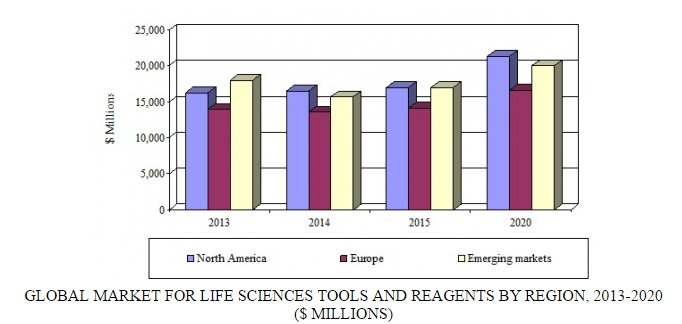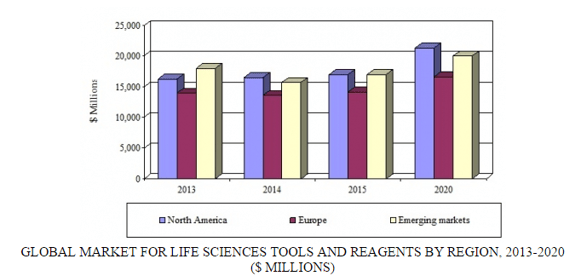
May 1, 2017
Blog Life Sciences PCR, Epigenetics Driving Global Life Science Tools and Reagents Market
Continual advances in technology, such as in polymerase chain reaction (PCR) and rapid diagnostics, are key areas of growth in the life science tools and reagents market. Increased interest in the disease identification process has led manufacturers to take initiatives in the development of varied epigenetic diagnostic techniques. BCC Research reveals that these and other innovations are spurring development of efficient, user-friendly, and affordable scientific techniques and products.
BCC Research predicts that the global life science tools and reagents market will increase at a five-year compound annual growth rate (CAGR) of 3.8% from 2015 to 2020, reaching $58 billion by the end of the period. Proteomics, which was the largest segment in 2015, is expected to slip to the second largest by 2020 with anticipated sales of $12.8 billion, reflecting a five-year CAGR of 2.6%. Genomics is expected to overtake proteomics as the largest segment by 2020 with sales of $12.9 billion, at a five-year CAGR of 4.2%. Growth in epigenetics should lead all segments during the forecast period, reaching sales of $2.1 billion by 2020 at a five-year CAGR of 6.9%.
The need for effective methods to investigate the underlying causes of diseases is driving the epigenetics tools and reagents market. The study of epigenetics is helping to unravel the mysteries of how changes in gene expression and modifications in the genetic material are causing numerous diseases. Until now, DNA modification was the focus of research in the area of epigenetics. However, recent alterations in RNA that affect biological processes are gaining importance.
“Developments in the field of RNA research, particularly RNA interference (RNAi), are showing promise for newer therapies for the treatment of neurodegenerative diseases as well as cardiovascular diseases,” says BCC Research analyst Shalini S. Dewan. “There is an ever-growing demand for high-throughput methods and ultrahigh–purity-grade reagents. Continuous improvements and innovations in this industry are enabling manufacturers to provide tools and reagents that are increasing the pace of research, which in turn is aiding the life science sector.”
Drivers of the global life science tools and reagents market include an aging population, longer life expectancies, favorable government policies, and the growing prevalence of chronic diseases. The aging population (individuals older than 65 years) will increase by 8% from 2015 to 2020. By 2020, 50% of global healthcare expenditures (approximately $4 trillion) will be spent on three leading causes of death: cardiovascular diseases, cancer, and respiratory diseases (Deloitte). Other growth factors include more R&D spending, growing competition, looming patent expiries, new product launches, and advances in PCR techniques, stem cell research, and molecular diagnostics.
Such technological advances are yielding different types of PCR techniques. In a separate analysis, Polymerase Chain Reaction (PCR) Technologies and Global Markets, BCC Research reported that the use of PCR technology continues to expand into nonconventional applications, producing solid growth in the global market. PCR allows DNA sequencing, as well as the production of millions of copies of a specific DNA sequence, within minutes. As a result, PCR technology has helped make molecular diagnosis easier and faster. It is used frequently to diagnose disease, identify bacteria and viruses, and aid forensic investigations.
BCC Research Looks at the Future of PCR
According to BCC Research’s estimates, the global market for PCR products is expected to reach $9.8 billion by 2021, reflecting a five-year CAGR of 4.4%. The United States has dominated the global PCR product market, accounting for $3.2 billion in 2015, a figure that should increase to nearly $4.5 billion by 2021. Continuous innovations and research efforts are growth factors. The European market, the next-largest segment, should total $2.7 billion by 2021 on the strength of increased product sales. In the emerging markets segment, growth factors such as the rapid increase in new medical technologies, improved diagnosis of diseases, and expansion of healthcare should drive this market to exceed $2.6 billion in 2021.
“Drivers of the PCR market include those related to technology, such as advances in instrumentation, reagents, and PCR techniques, and increasing R&D,” says Dewan. “Other factors related to health and healthcare, such as increasingly sedentary lifestyles; the growing incidence of diseases such as diabetes, cancer, and cardiovascular; and the increasing percentage of baby boomers are driving growth as well.”
Overall, novel diagnostic methods and newer therapeutics are primary market drivers of the global life science tools and reagents market. As such, technology developments such as in next-generation sequencing and single-cell genomics, as well as next-generation nuclear magnetic resonance instruments, benchtop mass spectrometers, and super-resolution microscopes, should also drive market growth.
GLOBAL MARKET FOR LIFE SCIENCE TOOLS AND REAGENTS BY REGION, 2013-2020

The global market for life science tools and reagents is expected to grow at a CAGR of 3.8% from 2015 to 2020, and is forecast to be worth $58 billion by 2020. According to BCC Research’s analysis, the North American life science tools and reagents market will grow at a five-year CAGR of 4.6% to reach $21.3 billion by 2020, mainly due to increased demand. In Europe, the growing interest in healthcare research is driving the market. The European life science tools and reagents market is expected to attain $16.6 billion by 2020, at a CAGR of 3.3%. In emerging markets, anticipated growth is attributed to the large consumer base, low-cost manufacturing capabilities, and favorable government policies. The revenue from life science tools and reagents in emerging countries will be close to $20 million by 2020, reflecting a five-year CAGR of 3.3%.
BCC Research’s study, Life Science Tools and Reagents: Global Markets, analyzes how scientific trends, government policies, and the economy in general affect this industry compared with pharmaceutical and drug discovery ventures. The report identifies existing products as well as potential markets for novel products and assay development. Analyses of global market drivers and trends are provided, with projections of CAGRs through 2020.
In today’s fast-paced biomedical world, researchers and pharmaceutical companies...

Radiopharmaceuticals represent a cutting-edge frontier in modern medicine, offer...

Implantable Remote Patient Monitoring (IRPM) devices are revolutionizing healthc...

We are your trusted research partner, providing actionable insights and custom consulting across life sciences, advanced materials, and technology. Allow BCC Research to nurture your smartest business decisions today, tomorrow, and beyond.
Contact UsBCC Research provides objective, unbiased measurement and assessment of market opportunities with detailed market research reports. Our experienced industry analysts assess growth opportunities, market sizing, technologies, applications, supply chains and companies with the singular goal of helping you make informed business decisions, free of noise and hype.